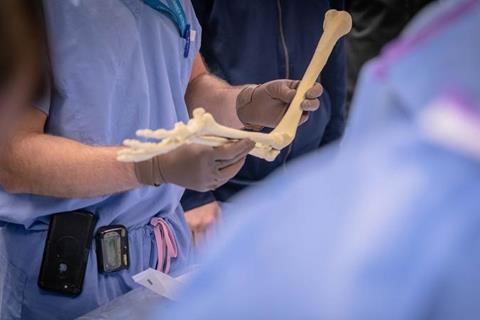West Virginia University researchers are working to potentially reduce the growing rate of antibiotic-resistant infections in open bone fractures by employing nanotechnology to bolster a centuries-old treatment.
More than 150,000 people in the United States suffer open bone fractures every year. About 10% of them will develop an infection which can lead to reduced limb function, secondary operations, delays in healing or death.

READ MORE: Nanoparticles with antibacterial action shorten duration of tuberculosis treatment
READ MORE: Ancient viral elements in RNA kickstart bone repair
“This high infection rate is complicated by antibiotic resistance,” said Bingyun Li, professor in the WVU School of Medicine Department of Orthopaedics. “We definitely need to reduce these types of infections because the consequences are serious.”
Silver and carbon nanotube
Antibiotic resistance results when bacteria gain the ability to defeat the medication prescribed to kill them and then multiply, furthering the infection. The Centers for Disease Control and Prevention calls it one of the most urgent threats to public health.
Li cited a recent Lancet article which showed more than one million people worldwide died as the result of bacterial antibiotic-resistant infections in 2021. That number is expected to double by 2050. Li’s 2017 work led him and his team to look for new solutions.
Their work focuses on developing a hybrid of two antimicrobial materials — silver and carbon nanotube — on the nanometer scale to reduce antibiotic-resistant infections in open fractures.
His study is supported by a $1.9 million grant from the National Institutes of Health’s National Institute of Allergy and Infectious Diseases and National Institute of General Medical Sciences.
Silver has long been used as an additive that provides protection against bacterial growth. Carbon nanotubes, which are used for medication delivery and noninvasive internal monitoring, possess antimicrobial properties.
Penetrate cell membranes and kill bacteria
“Nanotechnology lets us use particles that are very tiny, so they can go places that larger particles cannot. They can easily penetrate cell membranes and kill the bacteria,” Li explained. “There are also challenges because the particles may attack not just the bacteria, but also induce toxicity to human cells. One of our tasks will be to come up with the right type of formulation or size to be safe and more effective.”
Researchers will test the hybrid silver nanoparticle-carbon nanotube using human cells in a lab setting and in rats to determine how well it fights various bacteria while delivering a low toxicity toward human and rat cells. The composites also will be bioengineered as coatings on orthopedic implants to assess their antimicrobial properties.
Working with Li on the project are Dr. Matthew Dietz and Dr. Ming Pei, School of Medicine Department of Orthopaedics; Dr. Ryan Demkowicz, School of Medicine Department of Pathology, Anatomy and Laboratory Medicine, and Dale Porter, School of Medicine Department of Physiology, Pharmacology and Toxicology and the National Institute for Occupational Safety and Health. The team will recruit undergraduate, graduate and medical students to assist in the study.
Li said he hopes the study will expand beyond combatting antibiotic-resistant infections in bone fractures and show that nanohybrids could be engineered on various medical products such as bone grafts, dental implants, catheters, bandages and needles to prevent infections when these products are used for procedures.







No comments yet